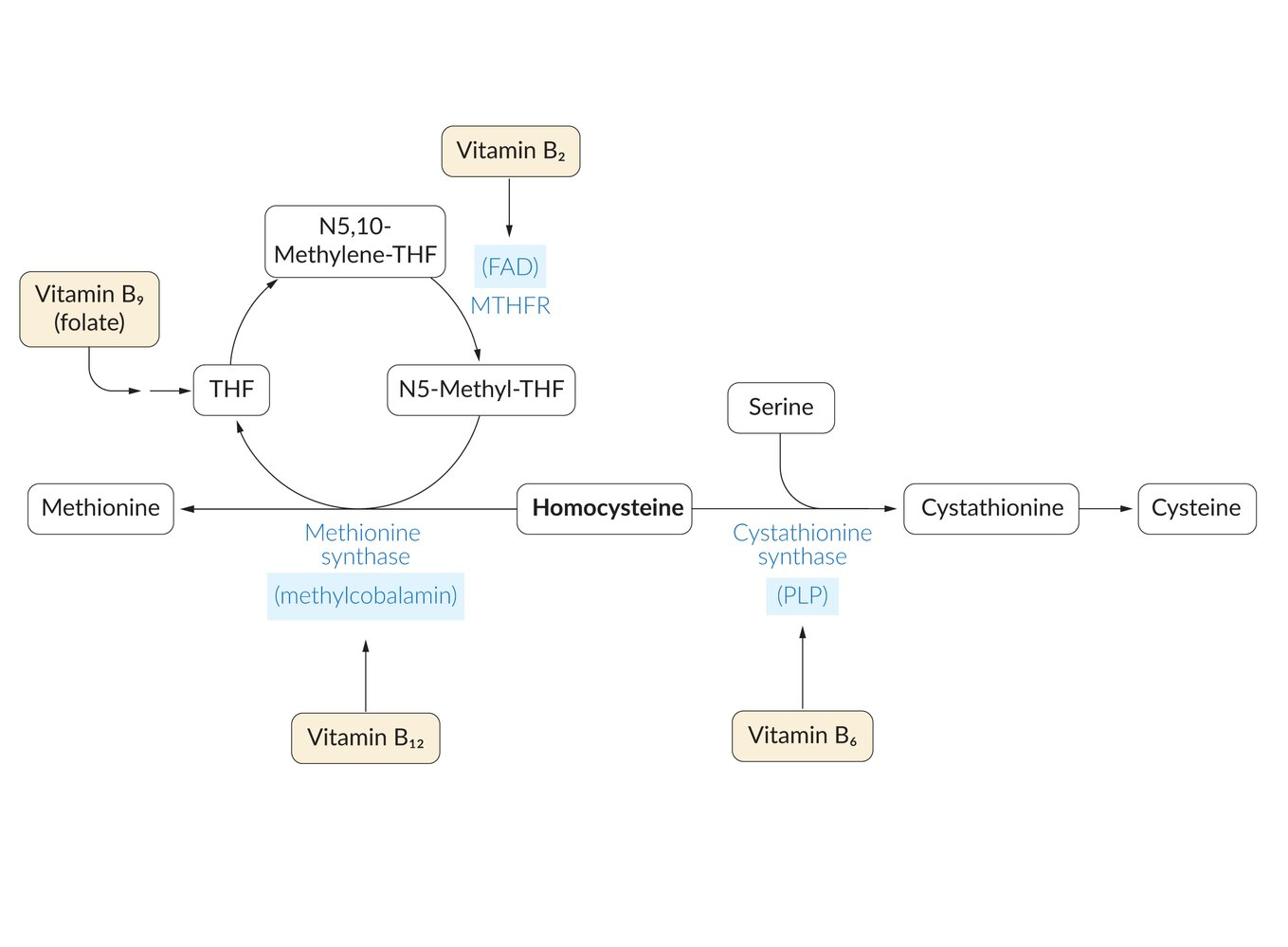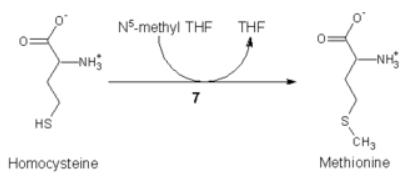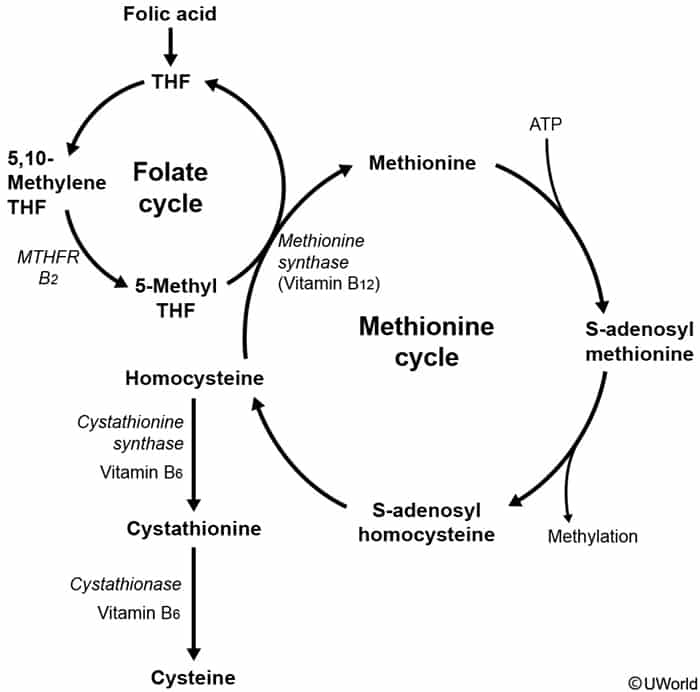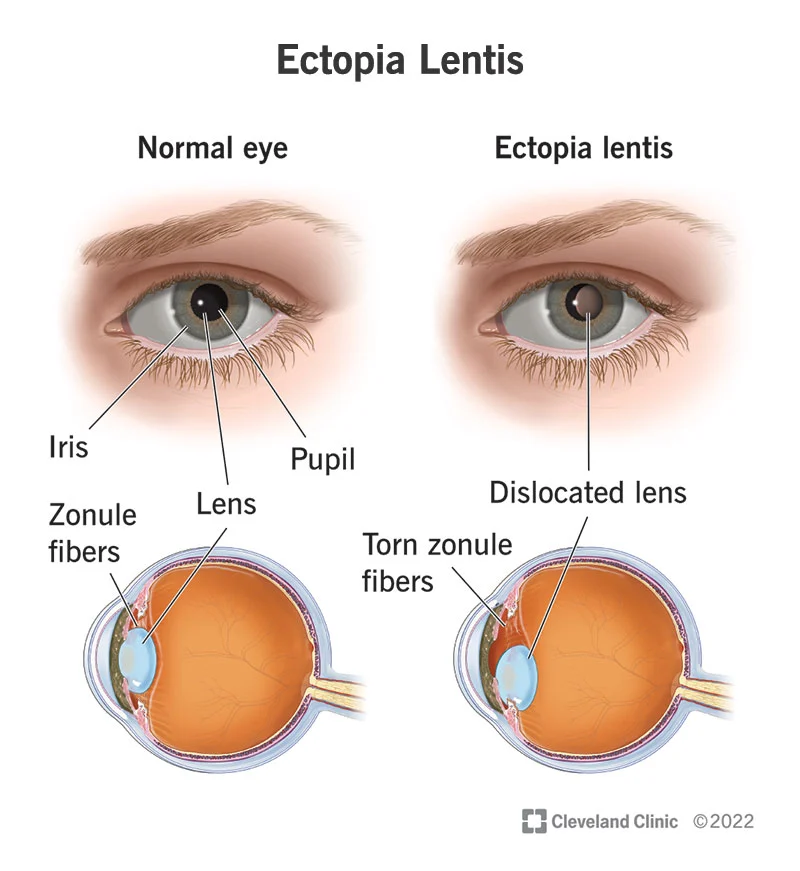Definition: a group of inherited genetic disorders characterized by impaired homocysteine metabolism
Homocysteine metabolism



- Remethylation Pathway (Methionine Cycle)
- Purpose: Regenerates methionine.
- Enzyme: Methionine synthase.
- Cofactors: Vitamin B12 (cobalamin) and 5-methyl-THF (from the folate cycle).
- Key Steps:
- Methionine is converted to S-adenosylmethionine (SAM), the universal methyl group donor for most methylation reactions in the body (e.g., DNA, RNA, neurotransmitter synthesis).
- Donation of a methyl group converts SAM to S-adenosylhomocysteine (SAH).
- SAH is hydrolyzed to homocysteine.
- Homocysteine is remethylated back to methionine. This reaction requires Vitamin B12 to accept a methyl group from 5-methyl-THF.
- Transsulfuration Pathway
- Purpose: Irreversibly converts homocysteine to cysteine. This is an essential pathway for cysteine synthesis.
- Enzymes & Cofactor:
- Cystathionine β-synthase (CBS): Combines homocysteine and serine to form cystathionine. Requires Vitamin B6 (pyridoxine) as a cofactor.
- Cystathionase: Cleaves cystathionine to form cysteine and α-ketobutyrate. Also requires Vitamin B6.
- Folate Cycle
- Purpose: To process dietary folate into forms that can donate one-carbon units for various metabolic reactions.
- Key Steps:
- Dietary folic acid is reduced to Tetrahydrofolate (THF) by dihydrofolate reductase (DHFR).
- THF is a one-carbon carrier; it can become 5,10-Methylene-THF, which is a key substrate for purine and thymidine synthesis.
- 5,10-Methylene-THF is irreversibly converted to 5-Methyl-THF by the enzyme Methylene-tetrahydrofolate reductase (MTHFR).
- Cofactor: Vitamin B2 (FAD).
- Function of 5-Methyl-THF: Its sole purpose is to donate a methyl group to homocysteine in the remethylation pathway.
Functions
Folate Cycle
- Supports DNA synthesis and repair (via dTMP and purine production, see De novo pyrimidine and purine synthesis)
- Enables methyl group transfer to regenerate methionine (links to methionine cycle)
- Facilitates serine/glycine interconversion (amino acid metabolism)
- Essential for cell growth, division, and genomic stability
Methionine Cycle
- Produces S-adenosylmethionine (SAM), the primary methyl group donor for methylation reactions (DNA, proteins, neurotransmitters, etc.)
- Regenerates methionine from homocysteine, preventing homocysteine toxicity
- Connects to the folate cycle (requires folate-derived methyl groups for homocysteine remethylation)
- Feeds the transsulfuration pathway for cysteine and glutathione synthesis
- Supports synthesis of polyamines, creatine, and phosphatidylcholine via methyltransfer reactions
Epidemiology
Etiology
- Autosomal recessive
- Cause deficiencies in one or more of the following enzymes
- Methionine synthase
- Cystathionine synthase: an enzyme that catalyzes the conversion of homocysteine and serine to cystathionine, using vitamin B6 as a cofactor.
- Methylenetetrahydrofolate reductase (MTHFR): an enzyme involved in folate metabolism that reduces N5,10-methylenetetrahydrofolate to methyltetrahydrofolate.
- Impaired affinity of cystathionine synthase for pyridoxal phosphate
Pathophysiology
- Methionine synthase (homocysteine methyltransferase) deficiency → impaired conversion of homocysteine into methionine
- Cystathionine synthase deficiency → impaired conversion of homocysteine into cystathionine
- All forms result in the accumulation of homocysteine.
Clinical features
- Nonspecific features in infancy: growth faltering, developmental delay
- Eyes
- Downward and inward subluxation of the ocular lens (ectopia lentis) after 3 years of age (in Marfan syndrome, the lens usually luxates upwards and outwards)

- Myopia and glaucoma later in life
- Downward and inward subluxation of the ocular lens (ectopia lentis) after 3 years of age (in Marfan syndrome, the lens usually luxates upwards and outwards)
- Progressive intellectual disability
- Psychiatric and behavioral disorders
- Light skin
- Marfanoid features
- Tall, thin
- Pectus deformities (e.g., pectus excavatum)
- Scoliosis
- Elongated limbs (↑ arm:height ratio; ↓ upper:lower body segment ratio), arachnodactyly
- Hyperlaxity of joints and hyperelasticity of the skin
- Osteoporosis
- Cardiovascular complications like thromboembolism, premature arteriosclerosis, and coronary heart disease increase the risk of myocardial infarction and stroke
Marfan Syndrome vs Homocystinuria
Link to original
Feature Marfan Syndrome Homocystinuria Inheritance Autosomal Dominant Autosomal Recessive Defect Fibrillin-1 Cystathionine synthase Lens Dislocation Upward (“Marfan looks up”) Downward (“Homocystinuria looks down”) Intellect Normal Intellectual disability CV Risk Aortic dissection/aneurysm Thromboembolism Treatment β-blockers, ARBs Vitamin B6 (Pyridoxine)
Diagnostics
- ↑ Homocysteine in urine and serum
- Urine sodium nitroprusside test: Urine changes color to an intense red in the presence of homocysteine.
- Serum methionine levels
- Increased in cystathionine synthase deficiency
- Decreased in methionine synthase deficiency and methylenetetrahydrofolate reductase deficiency
Treatment
- Some patients respond to large doses of pyridoxine (vitamin B6).
- Methionine synthase deficiency: high-methionine diet
- Cystathionine synthase deficiency
- Low-methionine, high-cysteine diet
- Supplementation of vitamin B12 and folate
- Impaired affinity of cystathionine synthase for pyridoxal phosphate: high-cysteine diet
- MTHFR deficiency: supplementation of folate